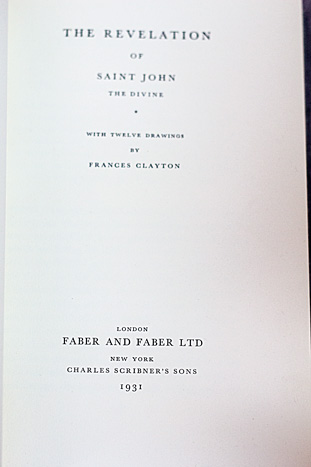Title: The Revelation of Saint John the Divine
Author: St. John, Frances Clayton (illus)
Publisher: The Curwen Press, Faber and Faber, 1931.
Condition: Signed by illustrator. Limited edition, no. 394 of 1,000 printed copies. 12 illustrators. Book in like-new condition, gilt to all edges. Comes with slipcase, some wear to slipcase.
About the Book:
The Book of Revelation, often known simply as Revelation or the Apocalypse, is the final book of the New Testament and occupies a central part in Christian eschatology. Written in Koine Greek, its title is derived from the first word of the text, apokalypsis, meaning “unveiling” or “revelation”. The author of the work identifies himself in the text as “John” and says that he was on Patmos, an island in the Aegean, when he was instructed by a heavenly figure to write down the contents of a vision. This John is traditionally supposed to be John the Apostle, although some historical-critical scholarship reject this view. Recent scholarship has suggested other possibilities including a putative figure given the name John of Patmos. Most modern scholars believe it was written around AD 95, with some believing it dates from around AD 70.
The book spans three literary genres: epistolary, apocalyptic, and prophetic. It begins with an epistolary address to the reader followed by an apocalyptic description of a complex series of events derived from prophetic visions which the author has seen. These include the appearance of a number of figures and images which have become important in Christian eschatology, such as the Whore of Babylon and the Beast, and culminate in the Second Coming of Jesus Christ. The obscure and extravagant imagery has led to a wide variety of interpretations: historicist interpretations see in Revelation a broad view of history; preterist interpretations treat Revelation as mostly referring to the events of the apostolic era (1st century), or—at the latest—the fall of the Roman Empire; futurists believe that Revelation describes future events; and idealist or symbolic interpretations consider that Revelation does not refer to actual people or events, but is an allegory of the spiritual path and the ongoing struggle between good and evil.
The Book of Revelation is the only apocalyptic document in the New Testament canon, though there are short apocalyptic passages in various places in the Gospels and the Epistles.






